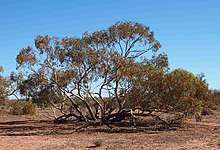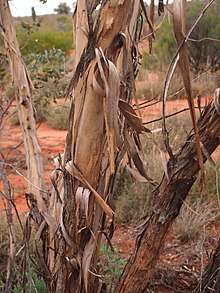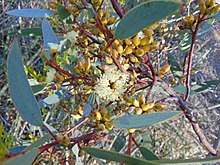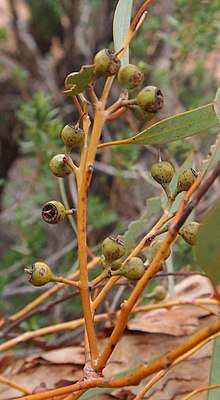Eucalyptus socialis
Eucalyptus socialis, commonly known as the red mallee,[2] or grey mallee,[3] is a species of mallee that is endemic to inland Australia.
| Red mallee | |
|---|---|
 | |
| Eucalyptus socialis | |
| Scientific classification | |
| Kingdom: | Plantae |
| Clade: | Tracheophytes |
| Clade: | Angiosperms |
| Clade: | Eudicots |
| Clade: | Rosids |
| Order: | Myrtales |
| Family: | Myrtaceae |
| Genus: | Eucalyptus |
| Species: | E. socialis |
| Binomial name | |
| Eucalyptus socialis | |



.jpg)
Description
Eucalyptus socialis is a mallee that typically grows to a height of 5 to 7 metres (16 to 23 ft), but can reach as high as 12 metres (39 ft), and forms a lignotuber. The canopy is about 5 metres (16 ft) wide. It usually has rough, grey bark on the trunk and smooth dull grey bark that is shed in long ribbons above. Young plants and coppice regrowth have stems that are square in cross-section and leaves that are dull green to greyish, egg-shaped to lance-shaped or elliptical, 40–80 mm (1.6–3.1 in) long and 18–42 mm (0.71–1.65 in) wide. Adult leaves are arranged alternately, the same dull green or greyish colour on both sides, lance-shaped, 50–140 mm (2.0–5.5 in) long and 10–22 mm (0.39–0.87 in) wide, tapering to a petiole 10–30 mm (0.39–1.18 in) long. The flower buds are arranged in leaf axils in groups of between seven and thirteen on an unbranched peduncle 4–23 mm (0.16–0.91 in) long, the individual buds on pedicels 3–8 mm (0.12–0.31 in) long. Mature buds are oval to spindle-shaped, 8–17 mm (0.31–0.67 in) long and 3–5 mm (0.12–0.20 in) wide with a conical, beaked or horn-shaped operculum 5–12 mm (0.20–0.47 in) long. Flowering occurs in most months and the flowers are white to pale yellow. The fruit is a woody urn-shaped to shortened spherical capsule 4–9 mm (0.16–0.35 in) long and 4–8 mm (0.16–0.31 in) wide with the valves enclosed but with the remains of the style protruding but fragile.[2][3][4][5][6]
Taxonomy
Eucalyptus socialis was first formally described by Friedrich Anton Wilhelm Miquel in 1856 in the journal Nederlandsch Kruidkundig Archief, from an unpublished description by Ferdinand von Mueller.[7][8]
The species name socialis a Latin word meaning "friendly", alluding to this species being associated with other eucalypt species as part of mallee communities.[9]
In 2005, Dean Nicolle described four subspecies of E. socialis and the names are accepted by the Australian Plant Census as at December 2019:
- Eucalyptus socialis subsp. eucentrica (L.A.S.Johnson & K.D.Hill) D.Nicolle[10][11] is distinguished from the other subspecies by the waxy coating on its branchlets and flower buds and by the dull bluish colour of its adult leaves;[12]
- Eucalyptus socialis F.Muell. ex Miq. subsp. socialis[13][14] has smaller leaves, buds and fruit than the other subspecies and creamy white flowers;[12]
- Eucalyptus socialis subsp. victoriensis D.Nicolle[15][16] has larger leaves, flower buds and fruit than the other subspecies and cream to pale yellow flowers;[12]
- Eucalyptus socialis subsp. viridans D.Nicolle [9][17] is mainly distinguised by its green, rather than bluish green leaves.[12]
E. socialis and E. gillii have undergone extensive hybridisation in parts of the Barrier Range of New South Wales.[2]
Distribution
It is one of the most widespread mallee species in Australia.[18] In Western Australia it is found on calcareous flats and rocky scree slopes in the Pilbara and Goldfields-Esperance regions where it grows in red-grey loam over limestone.[6] It is also found through much of South Australia, particularly in southern areas such as the Eyre Peninsula, Gawler Range, Flinders Ranges and Adelaide foothills where it is common.[19] The range extends into the southern part of the Northern Territory, where it is found in the Alice Springs region[20] and into parts of Queensland where it is found in open woodlands, where it often occurs with E. dumosa, E. gracilis and E. leptophylla.[21] In New South Wales it is found west from Condoblin with a sporadic distribution from Wilcannia. In these areas it is found in mallee shrubland communities on red aeolian sands.[2] In Victoria it is found in the north west of the state.[3]
Ecology
Following bushfires the species can resprout basally and has a mortality rate of less than 30% when 100% of leaves are scorched.[22]
Uses
E. socialis is suitable to produce large amounts of biomass, able to make 10 to 20 metric tons (11 to 22 short tons) per hectare per year. In wheatbelt regions it is also beneficial as the tree will reduce salinity, give shade to stock, act as a windbreak and reduce erosion.[18]
Traditional uses
Indigenous Australians used the tree for making bowls and medicines from the leaves, shields and spears from the bark and obtained water from roots.[23]
Use in horticulture
The plant is sold commercially and is noted for its ability to grow in poor soils. It is very attractive to bees[24] and butterflies who use the nectar for food from spring to summer during flowering.[23] It is drought- and salt-tolerant and will grow in full sun in well-drained soils. It is slow-growing but used in revegetation projects and as a small garden tree.[24]
See also
References
- "Eucalyptus socialis". Australian Plant Census. Retrieved 27 December 2019.
- K.Hill. "New South Wales Flora Online: Eucalyptus socialis". Royal Botanic Gardens & Domain Trust, Sydney, Australia.
- "Eucalyptus socialis F.Muell. ex Miq. Grey Mallee". VicFlora. Royal Botanic Gardens, Victoria. Retrieved 4 November 2017.
- "Eucalyptus socialis subsp. socialis". Euclid: Centre for Australian National Biodiversity Research. Retrieved 29 May 2020.
- Chippendale, George M. "Eucalyptus socialis". Australian Biological Resources Study, Department of the Environment and Energy, Canberra. Retrieved 27 December 2019.
- "Eucalyptus socialis". FloraBase. Western Australian Government Department of Parks and Wildlife.
- "Eucalyptus socialis". APNI. Retrieved 27 December 2019.
- Miquel, Friedrich A.W. (1856). "Stirpes Novo-Hollandas a Ferd Mullero collectas determinavit". Nederlandsch Kruidkundig Archief. 4 (1): 132–133. Retrieved 27 December 2019.
- "Eucalyptus socialis ssp. viridans (Myrtaceae) Green-leaved Red Mallee". Seeds of South Australia. Government of South Australia. Retrieved 4 November 2017.
- "Eucalyptus socialis subsp. eucentrica". Australian Plant Census. Retrieved 27 December 2019.
- "Eucalyptus socialis subsp. eucentrica". FloraBase. Western Australian Government Department of Parks and Wildlife.
- Nicolle, Dean (2013). Native Eucalypts of South Australia. Adelaide: Dean Nicolle. pp. 70–71. ISBN 9780646904108.
- "Eucalyptus socialis subsp. socialis". Australian Plant Census. Retrieved 27 December 2019.
- "Eucalyptus socialis ssp. socialis". LucidCentral. Retrieved 4 November 2017.
- "Eucalyptus socialis subsp. victoriensis". Australian Plant Census. Retrieved 27 December 2019.
- "Eucalyptus socialis subsp. victoriensis". FloraBase. Western Australian Government Department of Parks and Wildlife.
- "Eucalyptus socialis subsp. viridans". Australian Plant Census. Retrieved 27 December 2019.
- "Mallee". Biomass Producer. Australian Government. 2013. Retrieved 6 May 2017.
- "Eucalyptus socialis ssp. socialis (Myrtaceae) Summer Red Mallee". Seeds of South Australia. Government of South Australia. Retrieved 4 November 2017.
- "Eucalyptus socialis subsp. eucentrica F.Muell. ex Miq. (L.A.S.Johnson & K.D.Hill) Nicolle". NT Flora. Northern Territory Government. Retrieved 4 November 2017.
- Sandra L. Berry; Heather Keith; Brendan Mackey; Matthew Brookhouse; Justin Jonson (2010). Green Carbon: The Role of Natural Forests in Carbon Storage - Biomass Carbon Stocks in the Great Western Woodlands. Australian National University Press. ISBN 9781921666704.
- "Fire responses of Eucalyptus socialis". Northern Fire Manager. Retrieved 4 November 2017.
- "Trees sml – Eucalyptus socialis". Gawler NRC. Retrieved 4 November 2017.
- "Eucalyptus socialis (Red Mallee)". Nurseries online. Retrieved 4 November 2017.